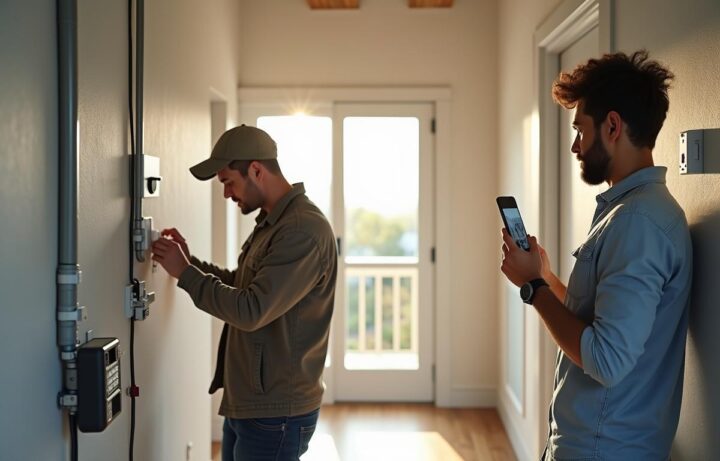Comparing Wired vs. Wireless Home Security Systems
Let’s explore the differences between wired and wireless home security systems. wireless home security systems can feel like a big decision, especially if you’ve just started exploring protection options. You want a setup that keeps your home and loved ones safe without causing extra headaches. Whether you’re upgrading an existing system or starting from scratch, it helps to learn the benefits and drawbacks of both technologies.

A little insight into daily maintenance, budget considerations, and potential home modifications will guide you toward a solution that fits your lifestyle. In the following sections, you’ll find suggestions on how each type of system performs in real-world scenarios, plus tips on staying ahead of common issues.
Core Differences in Setup
Wired systems have cables running through walls, attics, or crawl spaces, which can mean a more involved installation process. If you already have a pre-wired home, this might reduce some of the hassle. On the other hand, wireless installations skip the drilling and cutting and rely on radio signals. Because of this, they’re often considered more user-friendly in terms of setup. Yet, those signals depend on strong connectivity, which varies from one home to another.
Installation Timeline
Wired systems typically take longer to install because each sensor and camera needs physical wiring. Trained specialists or skilled DIY enthusiasts might have to fish cables through tight spaces. Wireless equipment usually installs faster, as you mainly place sensors and cameras where you need them. That means you don’t need to spend hours figuring out how to hide cables or patch up holes.
Compatibility and Scalability
Homes with existing alarm panels or older hardware tend to work well with wired equipment. It often integrates seamlessly with professional-grade systems. But if expanding coverage is on your to-do list, wireless hardware turns that process into a simpler task. You can add a motion sensor in the garage or a door sensor in your newly renovated basement without rewiring your space. Many people see this as a practical approach if they plan to add more components in the future or if they like experimenting with smart devices.
Day-to-Day Reliability and Maintenance
There’s a level of reliability in knowing your system won’t drop off if your Wi-Fi signal weakens. That peace of mind is why many homeowners still trust wired home security systems there’s a familiarity to a physical connection. However, wireless setups have improved dramatically over the years. With strong protocols and better hardware, they’re not as prone to interference as you might think.
Signal Strength and Interference
Wireless signals can encounter interference from thick walls, large metal appliances, or even neighboring networks. If you notice dropped connections, relocating a device or adjusting the router can help. In contrast, wired sensors rarely lose their link because of outside factors. Even so, there can be issues with cable damage, especially in older homes where rodents or wear and tear might gradually degrade certain sections of wiring.
Battery and Power Considerations
One major difference is how each system gets its power. Wired components typically run off your household electrical system, which reduces the need to swap batteries. But in the event of a power outage, you’ll need a backup battery if you want continuous coverage. Wireless sensors almost always rely on battery power, so routine battery checks become crucial. Some devices send notifications when they’re getting low, which helps you stay on top of replacements.
Key Cost Considerations
When it comes to the dollars and cents, wiring a system can initially be more expensive if your home isn’t already set up for it. The labor to run cables adds up, and you usually have to hire professionals for the job. Wireless equipment might have a higher price tag per device, but you could offset that with easier installation.
Initial Investment
If you’re building a new home or completely remodeling, investing in a wired solution might make sense. You can do all the wiring before the walls are sealed up. This approach could save you money down the line if you plan for everything correctly from the start. On the flip side, a wireless system can be more affordable upfront for established homes, since you won’t be ripping out drywall or hiring an electrician for complex cable runs. The core idea is to decide whether the convenience of drop-in sensors outweighs any added per-device cost.
Ongoing Fees
Some homeowners choose professional monitoring plans for both wired and wireless alarms. That monthly cost depends on your provider and the level of service you select. Cellular backup can also add costs, especially if you want constant connection even when the internet goes down. Wireless systems sometimes require you to subscribe to cloud storage for video clips or remote access features. That’s one reason it’s important to read the fine print. If you’re comfortable with local storage and plan to self-monitor, you can sidestep a few of those recurring fees.
Finding the Right Fit for Your Home
Deciding whether to go with a wired or wireless security system involves looking at your property’s structure, your ability (or willingness) to handle installations, and how far you’re willing to go in terms of monthly expenses. Homeowners who want minimal fuss and easy additions often opt for wireless. Meanwhile, those with a robust existing infrastructure or a brand-new build might lean toward a wired setup.
If you anticipate integrating home security with other systems like lighting controls, thermostats, or even voice assistants many modern wireless components come with built-in smart features. Yet, professionals can also integrate wired systems with advanced smart home setups for those who prefer a more permanent, hidden installation. It’s about matching the tech to your daily habits so that activating or monitoring it isn’t a chore.
Making Sense of Monitoring and Alerts
A well-planned security strategy often includes some form of monitoring, whether it’s self-managed or through a third-party service. Wired alarms typically route signals through a landline, which can still work during power losses if you have backup power. Wireless setups usually pair with a dedicated app or browser interface, letting you check cameras and receive notifications on the go.
Balancing Convenience and Control
Wireless systems can provide full control from your smartphone, even if you’re miles away. That can mean toggling alarms, viewing camera feeds, or granting temporary access to family members. Some people appreciate the hands-on nature of controlling everything from an app. Others favor the “set it and forget it” feel of a wired system that calls a monitoring center without needing much user interaction. Both approaches help protect your property, so it’s more about how involved you want to be day to day.
Combining Old and New
Certain homeowners blend wired and wireless devices. You might keep essential zones on a wired foundation but expand coverage with wireless sensors in areas where wiring is tough. For instance, if you’ve recently added a sunroom or workshop, a wireless camera can fill that gap quickly. If you’d like more insights on safeguarding additional areas, you can explore further resources on property protection strategies. This hybrid model offers double reassurance, plus the freedom to adapt as your needs evolve.
Where Does Each System Shine?
Wired security systems excel in stable environments where you know you won’t be rearranging furniture or renovating frequently. They’re also great if you crave a sense of permanence and trust in physical connections. Meanwhile, wireless systems shine when speed and flexibility are top priorities. Renters, in particular, can benefit from wireless solutions because they won’t lose their investment when they move. They can simply pack up sensors and reinstall them in the next place.
In many situations, families opt for wireless because of how easy it is to add features like smart locks or extra cameras. From burglary deterrence measures to 24/7 video monitoring, the possibilities expand rapidly in the wireless space. But the comfort of continuous reliability makes wired setups equally appealing to those who don’t want to fuss with signal variations or app updates. Ultimately, the best approach is one that aligns with your property’s layout, your comfort level with technology, and what you can realistically maintain.
Looking Ahead
It’s easier than ever to stay informed about home security. New technology hits the market regularly, improving both wired and wireless options. While wired systems deliver unmatched consistency in many homes, wireless setups offer that convenient, modern touch. Whichever route you choose, remember that regular upkeep is essential. Replace those batteries, update the firmware, test your sensors, and stay on top of potential expansions. With all these factors in mind, you’ll be well on your way to a reliable home security strategy that blends peace of mind with everyday convenience.


